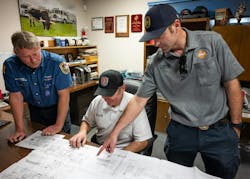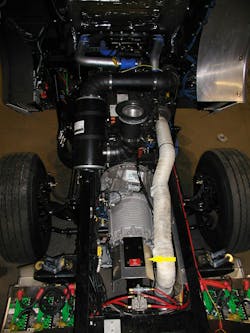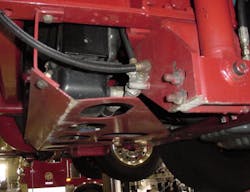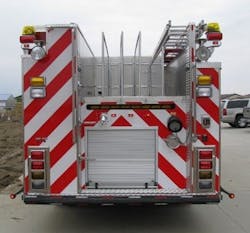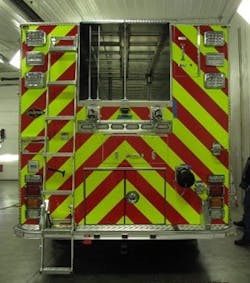Note: This article is part of the Firehouse 2024 Apparatus Supplement. To read the entire supplement, click here.
When fire departments purchase apparatus, they must develop a specification that becomes the document that apparatus manufacturers use as a guide to price and build the rig. Some departments choose to write a specification from scratch; some departments rely on a sales representative to write the specification; and some departments use a combination of the two. Whatever method that a department chooses to prepare the specification, groundwork must be accomplished to guide the specification writer. I call this groundwork the preparation of objectives. In other words, what are the “absolutes” that drive the preparation of the specification? The objectives aren’t meant to be specific or detailed but to provide the specification writer with the department’s desires so that person(s) can do the research to include the “absolutes” in the specification.
Who creates these objectives? The effort should be a collaboration between management and committee members who represent the end users so that the needs of the department and the needs of the end users are met. Little or no input from either management or the end users most likely results in an unsuccessful end product.
How do you start to develop these objectives? The following are eight simple questions that one can ask.
Budget
What is the budget? Whatever that number is, when applicable, be sure that it includes the sales tax, vehicle registration fees, and any other federal, state and local fees that might be applicable. The trick here is to ensure that the proposed budget allows for the purchase of an apparatus that meets the department’s needs.
Looking at recent similar purchases in your area might be a good place to start when researching the cost of a new fire apparatus. However, one must consider how long ago the contract for those purchases was signed. Delivery times have extended from 12–18 months just a few years ago to 24–30 months currently. Inflation over that period of time caused multiple price increases for most manufacturers. So, a fire apparatus that was delivered just a few months ago probably had a contract signed approximately 24 months ago, and the price of that vehicle when the contract was signed might not reflect the price increases that were imposed since then.
Sale representatives can be a good resource for this information, too. However, it must be understood that a sales representative doesn’t have a detailed specification at this point. Therefore, the price must be considered as only a raw estimate.
Success and failure
What works currently and what doesn’t? Evaluate the apparatus that’s being replaced to consider what works and what doesn’t. A detailed analysis of the vehicle that’s being replaced should include its mechanical workings, its functional capabilities and its equipment-carrying capabilities.
Often, the mechanical workings of the vehicle (or lack thereof) bring about a need for a solution to a problem. For example, if the vehicle that’s being replaced had suspension issues that were related to lack of lubrication, an objective that requests the need for an automatic chassis lubrication system could be added. That would inform the specification writer to add a detailed section on automatic chassis lubrication to the specification.
When reviewing the functional capabilities of the current vehicle, it might be determined, for example, that it can maneuver easily around a district that has hilly streets and tight turns. An objective that requests that the maximum wheelbase and turning radius don’t exceed the current vehicle’s characteristics would be required.
Evaluating the current compartment layout to determine whether it’s operationally functional could lead to a complete redesign of the new apparatus’ compartment layout. For instance, full-depth upper compartments (rescue side compartments) might be needed to carry an ever-increasing tool load. Always remember that there’s give and take when it comes to modifying compartment configurations. As an example, when adding rescue side compartments to a rig, there’s a loss of approximately 12 inches on each side to the rear hosebed, which will, in turn, cause the hose load to be taller.
Future needs
What’s lacking on the current apparatus that will be needed in the future? Future needs of the department might dictate the addition of specialized equipment, such as hydraulic rescue tools, in which case the person who creates the objectives should add the specifics of the new equipment.
Common components
Are there any components that would be a benefit if they are common with the department’s fleet or that have parts availability close by? This probably is more of an issue to be considered by a department that has a large fleet. However, smaller fleets also can benefit because of operator familiarity, familiarity for repair technicians, increased parts availability and potential warranty service availability. For example, a department used Brand X’s fire pumps in its pumping apparatus for years. All of the operators and service technicians are familiar with them. Unless there’s a justified need, moving away from Brand X pumps creates training issues for the operators and the technicians and possibly creates a need for a new parts supplier. One must carefully consider making component changes that require training and must understand that there must be a commitment to training the operators on the new components.
One large department (dozens of pumpers) decided to move to pressure governors from pressure relief valves. The department installed some governors on some current vehicles to test, with positive results. When new vehicles that had governors were delivered, the rigs were a total failure, mainly because the operators were unfamiliar with the governors and no adequate training was provided when the vehicles were put in service.
Minimum performance
What are the minimum performance requirements? If, for example, the fire district’s topography is extremely hilly, the speed requirements on specific grades should be articulated, so those requirements are included in the performance standards that are in the specification. This is important, because the performance standards might dictate the engine and drivetrain components that the manufacturer would include to meet this performance criteria. As well, parking on a grade that’s greater than 20 percent might require a front-wheel parking brake (highly recommended).
Safety features
Are there safety features that can be added to the apparatus? All manufacturers offer safety restraint systems, air bags, roll-over protection and Clean Cab options. Studies indicate that these systems provide an additional layer of protection for the occupants—at additional cost, of course.
As a precaution, be mindful of the manufacturer of the restraint system. Some of those companies offer their own proprietary systems, in which case your department might have to rely on them for repairs after the warranty period expires. Another choice would be to specify a restraint system that’s manufactured by an independent company that would offer the benefits of parts availability and repairs at a potential reduced cost.
On-board tools
What equipment is to be carried? A complete list of equipment that’s to be carried on the vehicle must be included with the specification. This is important to the manufacturer, because the weight of this equipment could cause the need for increased brake capability, increased axle and spring ratings, and tires that have increased load ratings. Should items be added at a later date, the load capacity of the vehicle could be exceeded, thus setting up the department for legal liability if the vehicle is involved in an accident.
Warranty
Was the warranty service on the vehicle that’s being replaced adequate? All new vehicles come with a manufacturer’s warranty. Warranty language that’s written by the manufacturer is legal jargon that most laypeople rarely understand. Most apparatus committee members don’t do enough research into the warranty language in the purchasing contract. I strongly suggest that one of the objectives that’s handed to the specification writer should be to add more detail to the warranty requirements. I don’t recommend that the specification writer use a manufacturer’s language, because each manufacturer has slightly different warranty coverages.
For instance, some departments don’t have the luxury of having a warranty service center in close proximity to their stations. What is the acceptable distance that the department is willing to travel to get a vehicle repaired? A requirement that the manufacturer is responsible for the transportation of the vehicle to the service facility could be included in the specification. That said, some manufacturers might agree to this, and some might not. However, putting it into the specification makes it clear what the department wants, and the manufacturer that bids on the project can take exception to this if it so desires, in which case the apparatus committee can evaluate the exception to see whether it wants to accept it.
Details
Once objectives are developed, they should be shared with the specification writer, so the objectives can be further detailed and articulated in the specification. The specification is where the technical details should be spelled out clearly. For example, the objective for the use of a Brand X pump would be added to the specifications, and much more detail regarding the components of the pump, the intake and discharge ports, and all of the desired options would be included.
Preparing specifications and purchasing apparatus are major undertakings that should be done in an orderly fashion and with an educated decision-making process. Creating objectives that clearly define the needs of the department greatly assists the specification writer with the preparation of the specifications.
About the Author

Greg Stone
Greg Stone is a retired 33-year veteran of the Los Angeles Fire Department. His assignments with the department included apparatus and equipment purchasing responsibilities. Additionally, Stone has 25 years of apparatus purchasing experience assisting other departments with their purchasing needs.
